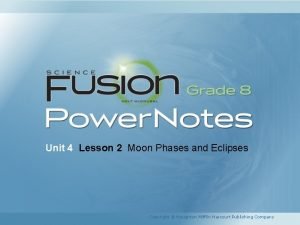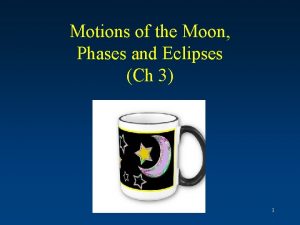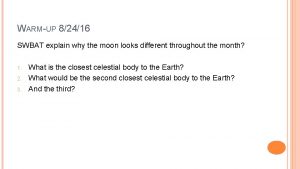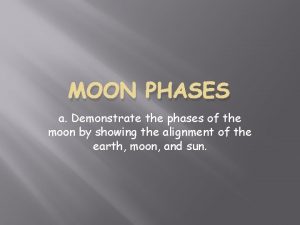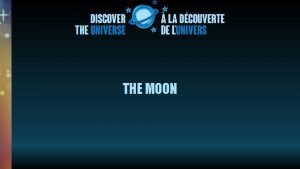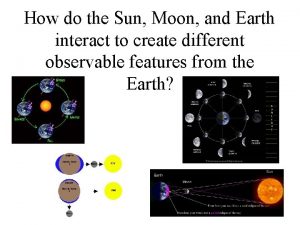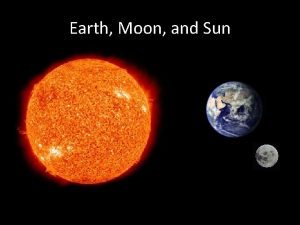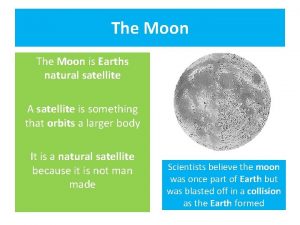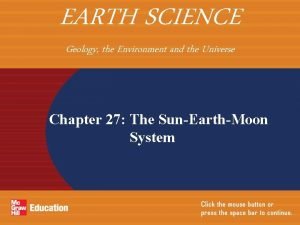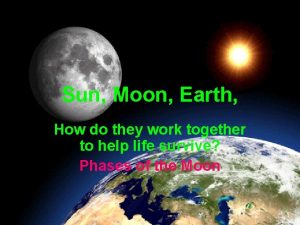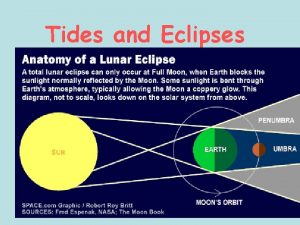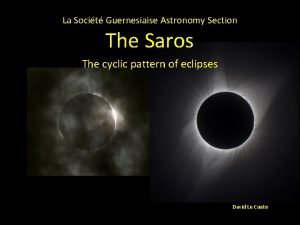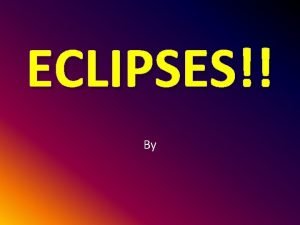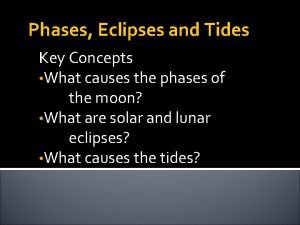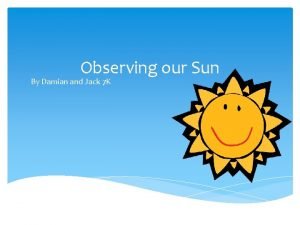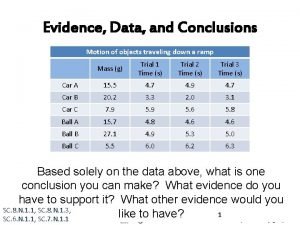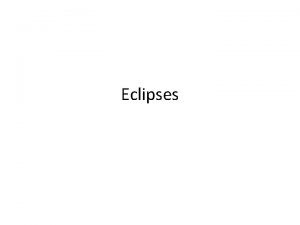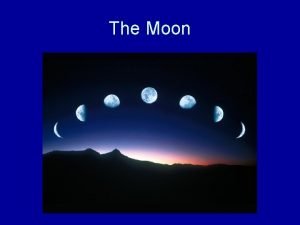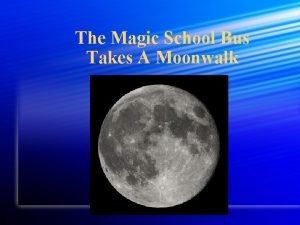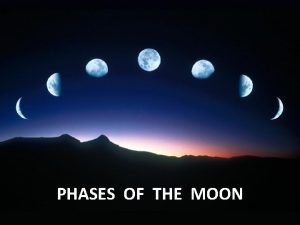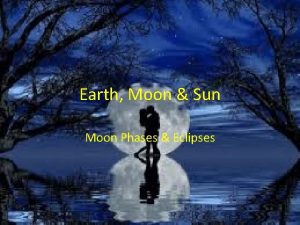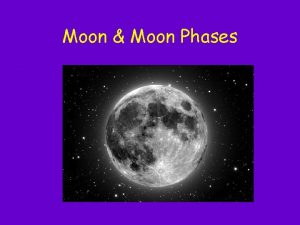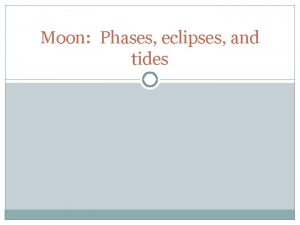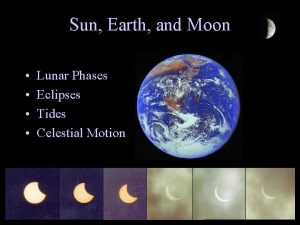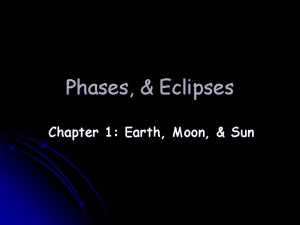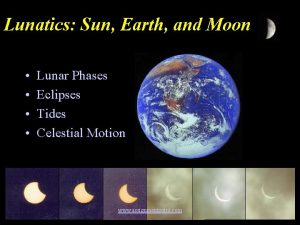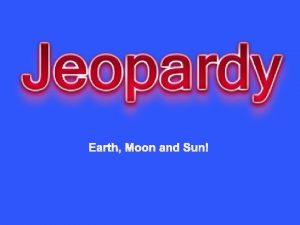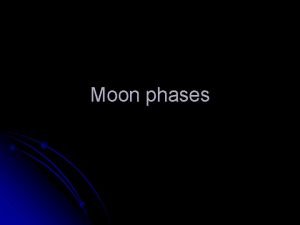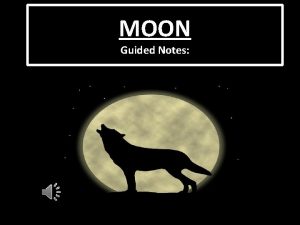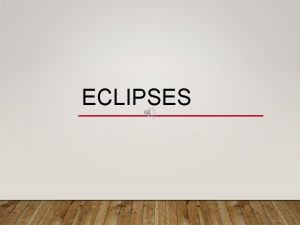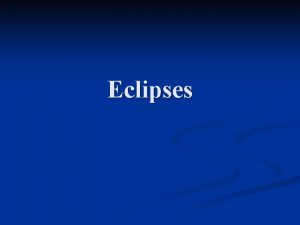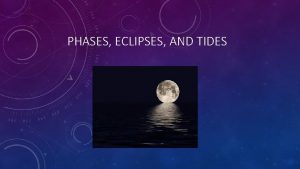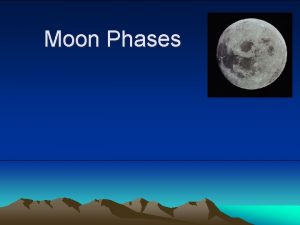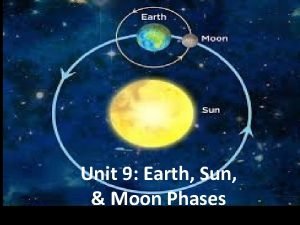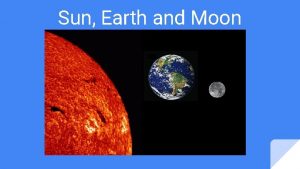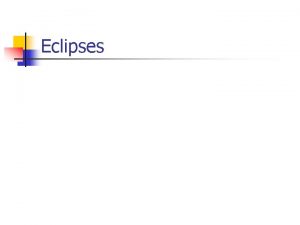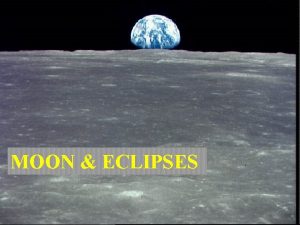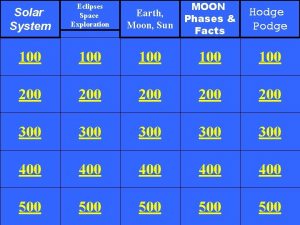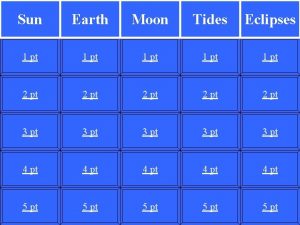Earth Moon Sun Moon Phases Eclipses Essential Standards


























- Slides: 26

Earth, Moon & Sun Moon Phases & Eclipses

Essential Standards • 6. E. 1 Understand the earth/moon/sun system, and the properties, structures and predictable motions of celestial bodies in the Universe.

Clarifying Objectives • 6. E. 1. 1 Explain how the relative motion and relative position of the sun, Earth and moon affect the seasons, tides, phases of the moon, and eclipses.

Essential Questions • How do the phases of the moon change as it REVOLVES around the Earth? • What are the positions of the sun, moon, & Earth during a solar & lunar eclipse? • How does rotation & revolution of the Earth affect units of time on Earth?

Phases of the Moon • The Earth is revolving around the sun • The moon is revolving around the Earth • The MOONS CHANGING IN POSITION IN RELATION TO THE SUN & THE EARTH causes moon phases • http: //www. youtube. com /watch? v=0 v. XWXq. Gm. PCk

Phases of the Moon • The moon is circling the Earth so we can only see part of the moon • Half of the moon is always lit up • Moonlight is just the sun’s light reflecting off the moon & into your eyes • http: //www. youtube. com /watch? v=Laqr. Qy. Tm 9 B 4 • 5: 11 -6: 20

Phases of the Moon • When the moon is in between the sun & the Earth we CAN’T see the moon • When the Earth is in between the sun & the moon we can see all of the lit side of the moon

Phases of the Moon • The moon cycles from New moon to Full moon every 29. 5 days • That is = to 1 month • We get our MONTHS from the Revolutions of the moon

Phases of the Moon • New (also called the Dark Moon) - not visible • Waxing Crescent • First Quarter - commonly called a "half moon" • Waxing Gibbous • Full - we can see the entire illuminated portion of the moon • Waning Gibbous • Third Quarter - another "half moon", but the illuminated part is opposite of the First Quarter • Waning Crescent • New - back to the beginning

NEW MOON The new moon is the first lunar/moon phase, when the Moon and Sun have the same ecliptic longitude. At this phase, the lunar/moon disk is not visible to the unaided eye, except when silhouetted during a solar eclipse. Daylight outshines the earthlight that dimly illuminates the new moon.

WAXING CRESCENT The moon is less than one-half illuminated by the sun but less than one quarter illuminated. Occurs when the moon's illumination is increasing, First Quarter. The moon is one-half illuminated by the sun.

FIRST QUARTER The First Quarter Moon is a primary Moon phase when we can see exactly half of the Moon's surface illuminated. If it is the left or right half, depends on where you are on Earth. A First Quarter Moon. This First Quarter Moon is in the Northern Hemisphere and mirrors approximately the calendar symbol.

WAXING GIBBOUS Waxing means that it is getting bigger. Gibbous refers to the shape, which is less than the full circle of a Full Moon, but larger than the semicircle shape of the Moon at Third Quarter. With some exceptions, the Waxing Gibbous Moon rises during the day, after noon.

FULL MOON The full moon is the lunar phase when the Moon appears fully illuminated from Earth's perspective. This occurs when Earth is located between the Sun and the Moon

WANING GIBBOUS Just after Full Moon, when the face of the Moon is 100% illuminated, the intermediate phase called Waning Gibbous Moon starts. Waning means that it is getting smaller. Gibbous refers to the shape, which is less than the full circle of a Full Moon, but larger than the semicircle shape of the Third Quarter Moon.

THIRD QUARTER The Third Quarter Moon is when the opposite half of the Moon is illuminated compared to the First Quarter. Which half you see lit up depends on where you are on Earth. The Third or Last Quarter Moon. The Third Quarter Moon is the last of the four primary Moon phases.

WANING CRESCENT During the Waning Crescent Moon phase, the illuminated part of the Moon decreases from the lit up semicircle at Third Quarter until it disappears from view entirely at New Moon. Waning means that it is getting smaller while crescent refers to the curved shape similar to a banana or a boat.

NEW MOON BACK TO THE BEGINNING

Essential Question? ? • Get with a partner or group and answer… • How do the phases of the moon change as it REVOLVES around the Earth? • Why do we see different phases of the moon?

Eclipses • Eclipses are what happen • http: //www. youtube. com/wat when the Earth casts a shadow ch? v=Laqr. Qy. Tm 9 B 4 on the moon or the moon casts a shadow on the Earth • 10: 07 -11: 59 • AN ECLIPSE IS WHENEVER SUNLIGHT IS BLOCKED • When the Earth casts a shadow on the moon we have a LUNAR ECLIPSE • When the moon casts it’s shadow on the Earth we have a SOLAR ECLIPSE

Lunar Eclipse • AN ECLIPSE IS WHENEVER SUNLIGHT IS BLOCKED • When the Earth casts a shadow on the moon we have a LUNAR ECLIPSE

Solar Eclipse • AN ECLIPSE IS WHENEVER SUNLIGHT IS BLOCKED • http: //www. youtube. co m/watch? v=Laqr. Qy. Tm 9 B 4 • When the moon casts • 10: 07 -11: 59 it’s shadow on the Earth we have a SOLAR ECLIPSE

Why don’t we get Eclipses every Month • We don’t get eclipses every month because the moon’s orbit is TILTED • If it was a straight line orbit we would get both a lunar & a solar eclipse every month • http: //www. youtube. co m/watch? v=Laqr. Qy. Tm 9 B 4 • 10: 07 -10: 51

Essential Question • Get with a partner or group and answer… • What are the positions of the sun, moon, & Earth during a solar & lunar eclipse?

EOG Questions • Which best explains why the moon has phases? • A) The moon’s position changes in relation to the sun and Earth. • B) The sun’s position changes in relation to the moon and Earth. • C) The Earth casts a shadow on the moon as it rotates. • D) The moon rotates along its axis.

Important Points • Moon phases happen because the MOON CHANGES POSITIONS as it revolves around the Earth • When you can’t see the moon it is called a NEW MOON • AN ECLIPSE IS WHENEVER SUNLIGHT IS BLOCKED • When the moon casts it’s shadow on the Earth we have a SOLAR ECLIPSE • When you see whole moon it is called a FULL MOON • When the Earth casts a shadow on the moon we have a LUNAR ECLIPSE • The moon makes a revolution around the Earth every 29. 5 days which is why we have a month • Moonlight is sunlight REFLECTING off the moon into your eyes
 Lesson 2 moon phases and eclipses answer key
Lesson 2 moon phases and eclipses answer key Facts about first quarter moon
Facts about first quarter moon Moon phases and eclipses
Moon phases and eclipses Phases of the moon sun on left
Phases of the moon sun on left Moon phases when the sun is on the left
Moon phases when the sun is on the left Does the moon rotate
Does the moon rotate How does the moon earth and sun work together
How does the moon earth and sun work together The sun-earth-moon system worksheet answers lesson 1
The sun-earth-moon system worksheet answers lesson 1 What season is this
What season is this Sun and earth relationship
Sun and earth relationship Pictures of other planets
Pictures of other planets Whats a natural satellite
Whats a natural satellite Chapter 27 study guide the sun-earth-moon system
Chapter 27 study guide the sun-earth-moon system How does the sun moon and earth work together
How does the sun moon and earth work together What type of tide occurs at a lunar and solar eclipse?
What type of tide occurs at a lunar and solar eclipse? The two eclipses
The two eclipses The two eclipses
The two eclipses The two eclipses
The two eclipses Eclipse tide
Eclipse tide Why is the sun so important
Why is the sun so important Que es una onda
Que es una onda Eclipses
Eclipses Eclipse brainpop
Eclipse brainpop Eclipses and tides lesson 3
Eclipses and tides lesson 3 4 phases of the moon
4 phases of the moon Magic school bus sun and moon
Magic school bus sun and moon Northern hemisphere moon phases
Northern hemisphere moon phases
